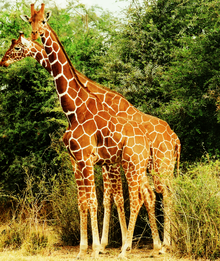Reticulated giraffe
| Reticulated giraffe | |
|---|---|
 |
|
| Scientific classification | |
| Kingdom: | Animalia |
| Phylum: | Chordata |
| Class: | Mammalia |
| Order: | Artiodactyla |
| Family: | Giraffidae |
| Genus: | Giraffa |
| Species: | G. reticulata |
| Binomial name | |
|
Giraffa reticulata (De Winton, 1899) |
|
 |
|
| Range map in red | |
The reticulated giraffe (Giraffa reticulata), also known as the Somali giraffe, is a species of giraffe native to Somalia, southern Ethiopia, and northern Kenya. There are approximately 8,500 individuals living in the wild.
Reticulated giraffes can interbreed with other giraffe species in captivity or if they come into contact with populations of other species in the wild. Once considered a subspecies of the conglomerate Giraffa camelopardalis species, recent studies identified the reticulated giraffe as a separate species of a reorganised Giraffa genus.
Together with the Rothschild giraffe, it is by far the giraffe most commonly seen in zoos. Its coat consists of large, polygonal, liver-colored spots outlined by a network of bright-white lines. The blocks may sometimes appear deep red and may also cover the legs. The extraordinary height of giraffes is attributed to a ritual known as "necking", where two males fight for reproduction rights by slamming their necks into one another. The giraffes with the tallest and strongest necks are victorious and allowed to reproduce, thus passing these genes on to future generations.
Giraffes historically occurred widely throughout Africa. Their favoured habitats are savannas, woodlands, seasonal floodplains, and rainforests.
Reticulated giraffes are herbivorous and have been recorded to feed on more than 100 species of plants, with a staple of Acacia, Commiphora, and Terminalia leaves. Giraffe have been seen eating the carcass of an antelope and chewing on dried bones for their calcium content. While leaves are preferred, a giraffe will browse on many other kinds of vegetation, especially in the dry season. Giraffe food preferences change according to seasons: in the dry season, they seem to be fine with pine-like needles. Giraffes feed by browsing, which typically means they eat continuously throughout the day. A male is able to eat 75 pounds of food in a single day. Giraffes use their sense of smell to locate the leaves they want. They ingest everything on the branch when eating, including insects, bark, and thorns. The giraffe uses its massive tongue (up to 18 in long) to scrape off the leaves. Giraffes have very tough lips to guard against scratching. While the acacia tree is their favorite, giraffes have also been known to eat mareola berries and other fruits. Reticulated giraffes are ruminants, just like cattle and other ungulates, and their stomachs have four parts, with food passing through the first and water going directly to the second. The first stomach partially digests the twigs, leaves, and whatever else the giraffe has ingested whole. During the day, when the animal is not feeding, parts of this fermented mixture are brought back up from the stomach in hard lumps (eructation). Giraffes chew on these lumps, called cud, throughout the day, helping to further break the food down. Once they are done chewing on the piece of cud, it is sent to the third stomach, and finally the fourth stomach to be digested fully.
...
Wikipedia

